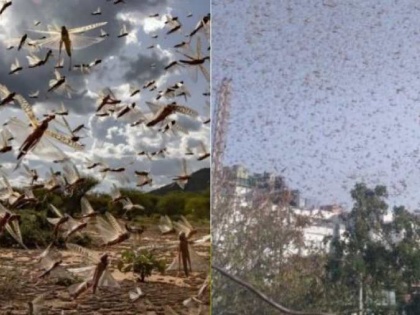All you need to know about Locusts Attack
By Lokmat English Desk | Published: May 27, 2020 12:04 PM2020-05-27T12:04:38+5:302020-05-27T12:05:06+5:30
The last couple of days have been a bit tough for the people of Rajasthan, Madhya Pradesh, and the ...

All you need to know about Locusts Attack
The last couple of days have been a bit tough for the people of Rajasthan, Madhya Pradesh, and the Vidharbha region of Maharastra due to the ferocious attack of locusts. The first swarms of locusts were spotted along the India-Pakistan border on April 11, months in advance ahead of the usual time of arrival. For the unversed, the desert locust is one of about a dozen species of short-horned grasshoppers. They are unique in the way that they change their behaviour – turning from solitary to “gregarious” or social insects that travel up to 150 km per day, eating up every bit of greenery on their way. These insects feed on a large variety of crops. If not controlled, locust swarms can lead to food insecurity in the country
Origins of the flying insects
This swarm originated in the Horn of Africa, where excess rains triggered a breeding boom. According to Indian experts, the swarm entering India now had another round of breeding in Baluchistan, Iran and Pakistan. In India, locusts are normally sighted during July- October along the Pakistan border. Last year, parts of Western Rajasthan and Northern Gujarat reported swarms that caused damage to growing rabi crops. These were the first swarms reported in India since 1997. This year, the first sightings of small groups were reported early
The extent damage caused by Locusts Attack
The current atatck is alarming in the Eastern Africa region. Over 25 million people will face acute food insecurity in the region in the second half of 2020. In Yemen, where locusts have been reproducing in hard-to-access inland areas, 17 million people may be impacted. A swarm of locust spread over a square kilometre can chew through food enough for 35,000 people in a day.
How can it be controlled
They can fly as far as 150km a day, making them difficult to control. Locust swarms can cover extremely large areas, which can sometimes be extremely remote and difficult to access. FAO monitors locust swarms on a 24-hour basis and provides forecasts and early warning alerts on the timing, scale and location of movement. Traditional chemicals are used to control their numbers. Now nature-based biopesticides are also available as a less harmful alternative for controlling outbreaks.
Ways to tackle locusts attack in India
The Locust Warning Organisation under the ministry of agriculture has a ground team of 50 people mainly to monitor and track the swarms; drones are used for aerial spraying of Malathion 96, an organophosphate insecticide and a potentially toxic chemical for non-cropped areas. For areas with agriculture, chlorpyrifos is sprayed by drones, fire brigades and tractor-mounted sprays.